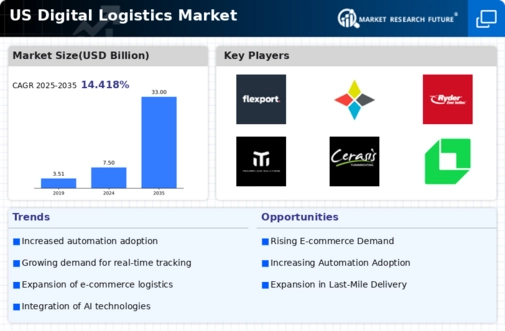Technological Advancements in Logistics
The digital logistics market is experiencing a surge in technological advancements that enhance operational efficiency. Innovations such as artificial intelligence (AI), machine learning, and the Internet of Things (IoT) are transforming traditional logistics processes. For instance, AI algorithms can optimize route planning, reducing transportation costs by up to 20%. Furthermore, IoT devices enable real-time tracking of shipments, improving visibility and customer satisfaction. As companies increasingly adopt these technologies, The digital logistics market was projected to grow at a CAGR of 10% through 2027, indicating a robust demand for tech-driven solutions.
Rising Fuel Costs and Efficiency Demands
Rising fuel costs are a significant concern for logistics companies, prompting a shift towards more efficient operations within the digital logistics market. As fuel prices fluctuate, companies are compelled to seek solutions that minimize transportation costs. Digital logistics technologies, such as route optimization software, can reduce fuel consumption by up to 15%, thereby enhancing profitability. Additionally, the focus on sustainability is pushing companies to adopt greener logistics practices, which often involve digital solutions. This dual pressure from fuel costs and efficiency demands is likely to propel the digital logistics market forward.
Regulatory Compliance and Safety Standards
Regulatory compliance is increasingly influencing the digital logistics market. The US government has implemented stringent safety and environmental regulations that logistics companies must adhere to. Compliance with these regulations often requires the adoption of digital solutions for tracking and reporting. For example, the Federal Motor Carrier Safety Administration mandates electronic logging devices for truck drivers, which has led to a rise in digital logistics solutions that ensure compliance. As companies navigate these regulations, the demand for digital logistics services that facilitate compliance is likely to increase, driving market growth.
E-commerce Growth and Consumer Expectations
The rapid growth of e-commerce is a primary driver of the digital logistics market. As online shopping becomes more prevalent, consumer expectations for fast and reliable delivery services are rising. In 2025, it is estimated that e-commerce sales in the US will reach $1 trillion, necessitating efficient logistics solutions to meet demand. Companies are investing in digital logistics to streamline their supply chains and enhance last-mile delivery capabilities. This shift not only improves customer satisfaction but also positions businesses competitively in a crowded marketplace, further fueling the growth of the digital logistics market.
Integration of Supply Chain Management Systems
The integration of supply chain management systems is a crucial driver of the digital logistics market. Companies are increasingly recognizing the importance of seamless communication and data sharing across their supply chains. Advanced digital logistics platforms facilitate this integration, allowing for better inventory management and demand forecasting. In 2025, it is projected that 60% of logistics companies will utilize integrated systems to enhance operational efficiency. This trend not only streamlines processes but also reduces costs, making it a vital component of the digital logistics market's growth trajectory.
























Leave a Comment